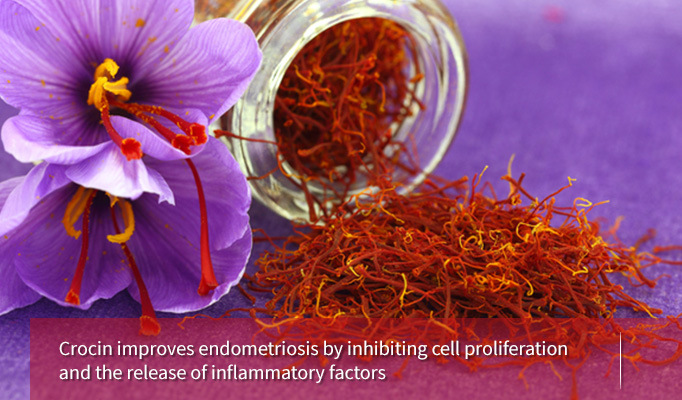-
Crocin
-
- Antioxidant, Carotenoid, Phytochemical, [Group: Gardenia], [Group: Saffron]

-
-
Untitled Document
Crocin is a water-soluble carotenoid pigment of saffron (Crocus sativus L. ) that has been used as a spice for flavoring and coloring food preparations, and in Chinese traditional medicine as an anodyne or tranquilizer. Saffron is now used worldwide in folk medicine and is reputed to be useful in treating various human disorders such as heart and blood disorders. Stroke and heart attack are involved in reputed folkloric uses of saffron. Saffron is orally administrated as a decoction. Saffron extract exerts a protective effect on renal ischemia reperfusion induced oxidative damage in rats. Crocin suppresses tumor necrosis factor (TNF)alpha-induced apoptosis of pheochromocytoma (PC12) cells by modulating mRNA expressions of Bcl-2 family proteins, which trigger downstream signals culminating in caspase-3 activation followed by cell death. Depriving cultured PC12 cells of serum/glucose causes a rapid increase in cellular ceramide levels, followed by an increase in the risk of cell death. The accumulation of ceramide was found to depend on the activation of neutral sphingomyelinase (nSMase). Crocin prevented the activation of nSMase by enhancing the transcription of gamma-glutamylcysteinyl synthase, which contributes to a stable glutathione supply that blocks the activity of nSMase. (PMID: 17215084). Crocetin esters present in saffron stigmas and in Gardenia jasminoides Ellis fruit are the compounds responsible for their color.(PMID: 16448211).
Crocin-1 is a diester that is crocetin in which both of the carboxy groups have been converted to their gentiobiosyl esters. It is one of the water-soluble yellow-red pigments of saffron and is used as a spice for flavouring and colouring food. Note that in India, the term 'Crocin' is also used by GlaxoSmithKline as a brand-name for paracetamol. It has a role as an antioxidant, a food colouring, a plant metabolite and a histological dye. It is a diester, a disaccharide derivative and a diterpenoid. It derives from a beta-D-gentiobiosyl crocetin and a gentiobiose.
Crocin has been investigated for the treatment of Hyperglycemia, Metabolic Syndrome, Hypertriglyceridemia, and Hypercholesterolemia.
-
Untitled Document
For chronic supplementation, take 15 mg of saffron, twice a day. This is the advised upper limit for constant supplementation. Preliminary evidence suggests that doubling this dose may have a toxic effect after eight weeks of continuous usage. Acute, single doses of saffron, can be as high as 200 mg.
Saffron can be supplemented by taking water extracts of the stigma (the red part of the plant, used as a spice) or by using the dehydrated stigma itself. Some evidence suggests that the petals of saffron may also be effective.
Saffron can be taken twice a day in a supplement form, or at meals as a spice.
Doses above 1,200 mg may cause nasea and vomiting. *
Note 4: Toxicology effects of saffron and its constituents: a review
-
Untitled Document
Supplementation of saffron at doses higher than normal (200 mg) in humans has been associated with some alterations in blood and hemodynamic parameters that, while statistically significant, where not of large enough magnitude to be considered adverse, although abnormal uterine bleeding was found in two women at doses of 200-400mg. Doses of 1,200-2,000 mg saffron in humans can acutely cause symptoms such as nausea, vomiting, diarrhea, and bleeding.
More prolonged supplementation (26 weeks) with 60mg saffron daily in men was associated with reductions in red and white blood cell counts as well as platelets, along with a drop in systolic and diastolic blood pressure of 10.8-11.7% and complaints of sedation, hypomania, and changes in appetite which started to occur after 8 weeks of exposure and increased in magnitude as the study proceded.
Saffron appears to be well-tolerated acutely at the normal doses (30 mg daily), whereas higher doses for more prolonged periods can induce adverse effects. *
Note 3: Sensitive analysis and simultaneous assessment of pharmacokinetic properties of crocin and crocetin after oral administration in rats
2023-03-13

